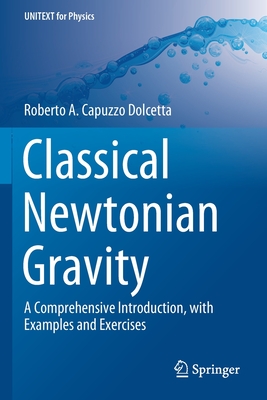You are here
Back to topClassical Newtonian Gravity: A Comprehensive Introduction, with Examples and Exercises (Unitext for Physics) (Paperback)
$63.24
Usually Ships in 1-5 Days
Description
Chapter 1.- Elements of Vector Calculus.- 1.1 Vector Functions of Real Variables.- 1.2 Limits of vector Functions.- 1.3 Derivatives of Vector Functions.- 1.3.1 Geometrie Interpretation.- 1.4 Integrals of Vector Functions.- 1.5 The Formal Operator Nabla, ∇.- 1.5.1 ∇ in Polar Coordinates.- 1.5.2 ∇ in Cylindrical Coordinates.- 1.6 The Divergence Operator.- 1.7 The Curl Operator.- 1.8 Divergence and Curl by Means of ∇.- 1.8.1 Spherical Polar Coordinates.- 1.8.2 Cylindrieal Coordinates.- 1.9 Vector Fields.- 1.9.1 Field Lines.- 1.10 Divergence Theorem.- 1.10.1 Velocity Fields.- 1.10.2 Continuity Equation.- 1.10.3 Field Lines of Solenoidal Fields.- Chapter 2 Potential Theory.- Discrete mass distributions.- 2.1 Single particle gravitational potential.- 2.2 The gravitating N body case.- 2.3 Mechanical Energy of the N bodies.- 2.4 The Scalar Virial Theorem.- 2.4.1 Consequenees of the Virial Theorem.- 2.5 Newtonian Gravitational Force and Potential.- 2.6 Gauss Theorem.- 2.7 Gravitational Potential Energy.- 2.8 Newton's Theorems.- Chapter 3.- Central Force Fields.- 3.1 Force and Potential of a Spherical Mass Distribution.- 3.2 Circular orbits.- 3.2 Potential of a Homogeneous Sphere.- 3.3.1 Quality of Motion.- 3.3.2 Particle Trajectories.- 3.4 Periods of Oscillations.- 3.4.1 Radial and Azimuthal Oscillations.- 3.4.2 Radial Oscillations in a Homogeneous Sphere.- 3.4.3 Radial Oscillations in a Point Mass Potential.- 3.5 The Isochrone Potential.- 3.6 The Inverse Problem in Spherical Distributions.- Chapter 4.- Potential Series Developments.- 4.1 Fundamental Solution of Laplace'sChapter 1.- Elements of Vector Calculus.- 1.1 Vector Functions of Real Variables.- 1.2 Limits of vector Functions.- 1.3 Derivatives of Vector Functions.- 1.3.1 Geometrie Interpretation.- 1.4 Integrals of Vector Functions.- 1.5 The Formal Operator Nabla, ∇.- 1.5.1 ∇ in Polar Coordinates.- 1.5.2 ∇ in Cylindrical Coordinates.- 1.6 The Divergence Operator.- 1.7 The Curl Operator.- 1.8 Divergence and Curl by Means of ∇.- 1.8.1 Spherical Polar Coordinates.- 1.8.2 Cylindrieal Coordinates.- 1.9 Vector Fields.- 1.9.1 Field Lines.- 1.10 Divergence Theorem.- 1.10.1 Velocity Fields.- 1.10.2 Continuity Equation.- 1.10.3 Field Lines of Solenoidal Fields.- Chapter 2 Potential Theory.- Discrete mass distributions.- 2.1 Single particle gravitational potential.- 2.2 The gravitating N body case.- 2.3 Mechanical Energy of the N bodies.- 2.4 The Scalar Virial Theorem.- 2.4.1 Consequenees of the Virial Theorem.- 2.5 Newtonian Gravitational Force and Potential.- 2.6 Gauss Theorem.- 2.7 Gravitational Potential Energy.- 2.8 Newton's Theorems.- Chapter 3.- Central Force Fields.- 3.1 Force and Potential of a Spherical Mass Distribution.- 3.2 Circular orbits.- 3.2 Potential of a Homogeneous Sphere.- 3.3.1 Quality of Motion.- 3.3.2 Particle Trajectories.- 3.4 Periods of Oscillations.- 3.4.1 Radial and Azimuthal Oscillations.- 3.4.2 Radial Oscillations in a Homogeneous Sphere.- 3.4.3 Radial Oscillations in a Point Mass Potential.- 3.5 The Isochrone Potential.- 3.6 The Inverse Problem in Spherical Distributions.- Chapter 4.- Potential Series Developments.- 4.1 Fundamental Solution of Laplace's Equation.- 4.2 Harmonic Functions.- 4.3 Legendre's Polynomials.- 4.4 Recursive Relations.- 4.4.1 First Recursive Relation.- 4.4.2 Second Recursive Relation.- 4.5 Legendre Differential Equation.- 4.6 Orthogonality of Legendre's Polynomials.- 4.7 Development in Series of Legendre's Polynomials.- 4.8 Rodrigues Formula Chapter 5.- Harmonic and Homogeneous Polynomials.- 5.1 Spherical Harmonics.- 5.2 Solution of the Differential equations for Sm(θ, ϕ).- 5.3 The Solution in ϕ.- 5.4 A note on the Associated Legendre Differential Equation.- 5.5 Zonal, Sectorial and Tesseral Spherical Harmonics.- 5.5.1Orthogonality Properties.- Chapter 6.- Series of Spherical Harmonics.- 6.1 Potential Developm.
About the Author
Roberto A. Capuzzo-Dolcetta worked for 20 years as a full-time researcher at the University of Roma La Sapienza, until, in July 2000, he became Associate Professor in Astronomy and Astrophysics, where he is now teaching Fluid dynamics for Astrophysics and Theoretical Astrophysics. He has also a long term experience in teaching Gravitational Physics and Theoretical Mechanics at both undergraduate and graduate level. He has also been teaching in the United States, delivering, for instance, the undergraduate course on Extragalactic Astronomy and Cosmology at the University of Washington and Seattle and presenting lectures for graduate students at Boston University. Since May 2010 he has been a scientific reviewer for ISCRA (Italian Super Computing Research Allocation) at CINECA and leader of the panel of Universe Science of the Access Committee of PRACE (the european infrastructure for super computing). His research activity is mainly theoretical, in the field of stellar clusters, bothgalactic and extragalactic. He is an expert in sophisticated numerical methods to deal with large self-gravitating N-body systems. He has obtained important results concerning the evolution and dynamics of the globular cluster systems in galaxies, and proposed a new original explanation for mass accretion and activity of galactic nuclei. He is the author of more than 200 scientific papers in international journals.
